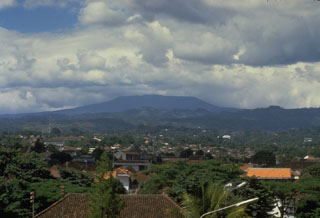Report on Tangkuban Parahu (Indonesia) — March 1986
Scientific Event Alert Network Bulletin, vol. 11, no. 3 (March 1986)
Managing Editor: Lindsay McClelland.
Tangkuban Parahu (Indonesia) Inflation; tremor; high fumarole temperatures
Please cite this report as:
Global Volcanism Program, 1986. Report on Tangkuban Parahu (Indonesia) (McClelland, L., ed.). Scientific Event Alert Network Bulletin, 11:3. Smithsonian Institution. https://doi.org/10.5479/si.GVP.SEAN198603-263090
Tangkuban Parahu
Indonesia
6.77°S, 107.6°E; summit elev. 2084 m
All times are local (unless otherwise noted)
Fumaroles of the Kawah Baru field continued to have elevated temperatures that ranged from 152 to 158°C during March. Seismic tremor was recorded on the seismometer at Kawah Ratu on 17 March, from about 0900 until 2400. Tremor was again recorded briefly on 18 and 19 March.
"During March the complete EDM network was reoccupied for the first time since 1983. The results of the survey are consistent with long term inflation of Tangkubanparahu as detected by spirit level tilt measurements from 1981 through January 1986. The center of inflation . . . is located at Kawah Upas, ~500 m E of the Kawah Baru fumaroles. The epicentral area of the late 1983 seismic activity was in the S half of Kawah Upas, approximately coincident with the center of uplift determined from tilt measurements."
Geological Summary. Gunung Tangkuban Parahu is a broad stratovolcano overlooking Indonesia's former capital city of Bandung. The volcano was constructed within the 6 x 8 km Pleistocene Sunda caldera, which formed about 190,000 years ago. The volcano's low profile is the subject of legends referring to the mountain of the "upturned boat." The Sunda caldera rim forms a prominent ridge on the western side; elsewhere the rim is largely buried by deposits of the current volcano. The dominantly small phreatic eruptions recorded since the 19th century have originated from several nested craters within an elliptical 1 x 1.5 km summit depression.
Information Contacts: Kaswanda, H. Said, A. Sudradjat, and T. Casadevall, VSI.

